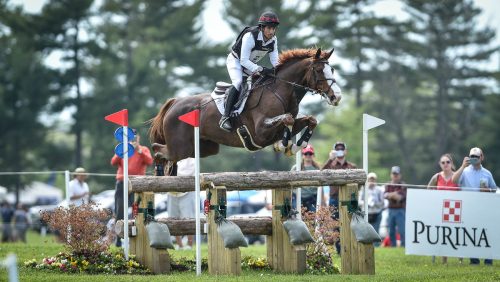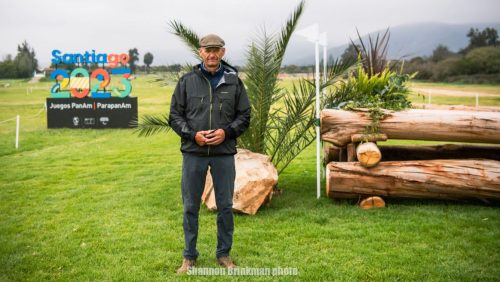Any U.S. Eventing Association members who headed to Nashville, Tenn., for the Annual Meeting and Convention on Dec. 7-11 hoping to hear a decision on the reconsideration of the “one fall, and you’re out” rule were sorely disappointed. Because at the conclusion of the weekend, the usually forthright Malcolm Hook, chair of the U.S. Equestrian Federation’s Eventing Technical Committee, was still keeping his cards close to his chest.
Ever since the section of EV142 that eliminates riders who have fallen related to a cross-country obstacle took effect in late 2008, a strong contingent of USEA members has been lobbying for its repeal. USEA and USEF leaders announced earlier this year that they would reconsider the rule for training level and below—but there were no guarantees it would be repealed.
“I have a very firm position on this, but I’m not going to state it in things like the open rule change forum, because it’s very easy to make it sound like I’m only advocating for my viewpoint,” said Hook. “But I want the Eventing Committee to have as much information as possible before we make this decision. I was really disappointed that so few people were in Dr. Dave Halstead’s presentation [on concussion research advancements on Friday]. I’m going to burn DVDs and make sure every committee member gets one. But until the Eventing Committee has made its decision, most of our discussions on it are private. We’ll decide [at the USEF Meeting in January] in Cincinnati.”
Hook and the USEA Board strove valiantly to keep the public debates on the issue to a minimum, as it’s already been picked apart thousands of times. But opinions were, of course, passionately expressed at times over the weekend, including in Friday’s rule change open forum.
In particular, riders and officials debated the wording of the current rule change proposal, EV 142.4d, which, unlike the original pre-2008 rule (which allowed riders to remount unless they had exceeded the time limit) states:
“At the beginner novice, novice and training levels, a rider who falls once may continue, provided that he maintains control of his horse and can re-mount immediately. Should the horse escape, or the rider require medical evaluation, he will be eliminated. If an air vest has deployed it must be deflated or removed before the rider may continue. No time-out will be employed in this eventuality.”
All in attendance seemed to agree that wording like “maintains control of his horse” and “immediately” were too ambiguous to instate as rules and would only lead to confusion and conflict if put into practice. Additionally, they agreed that rules shouldn’t encourage a rider to be desperate to “maintain control” so as not be eliminated and latch a death grip onto her horse’s reins and get dragged after a fall.
But the agreements ended there.
ADVERTISEMENT
In the rule change open forum, Hook, who is also the co-chair of the USEF Safety Committee, offered the quintessential cautionary tale: He said less than a week prior, at a USEF-recognized hunter/jumper show in northern Illinois, a rider had fallen off in a 3’3” class, hit her head, told the steward she was fine and walked back to the barn.
“She started feeling sick when she got back to her stall, started vomiting, went to the medics, they transported her to the hospital, and a few hours later she was dead,” he said.
That’s when Carol Kozlowski, USEA vice president of safety, chimed in, saying she actually supported the reversal of the fall rule.
“You might find that totally in contradiction with my role as VP, but I don’t think the two [beliefs] are mutually exclusive,” she said. “It all goes back to the fact that riders want to take responsibility for their lives—they do not want it legislated away from them.
“Safety has gone through the roof,” she continued. “After a crisis in our sport, we’ve jumped through major hoops to improve safety. But this [fall and elimination rule], to me, starts to take on a little ‘Big Brother’ mentality—‘We know what’s best for you’—and that frightens me.”
USEA President Brian Sabo noted that at last year’s convention, his first in that role, he’d given out his phone number and email to everyone he met and encouraged them to contact him at any time about any subject.
“I got literally hundreds of emails about this, and the large majority of people really don’t like this rule,” he said. “The upper-level riders, when they have 65 penalties, they’re walking off the course and just coming back next weekend.”
But those at lower levels, he said, really want the chance to get on and keep going and learn. For most amateurs and juniors, competing is rare, and they may not get another chance until weeks or months down the road. Plus, since 2008, British Eventing data has shown that riders who fall once are no more likely to have a second fall, which was a major concern at the time the U.S. rule was instated.
ADVERTISEMENT
“In Britain, there is no cry to have a ‘one fall and out’ rule, because they’re not having a problem with it, and they’ve never had a problem with it. We need to get back on our horses when possible and finish the darn course,” Sabo concluded, eliciting a big round of applause, after which British Eventing board member Giles Rowsell rose to add his two cents.
“Our riders say this is simply not an issue,” Rowsell said. “But there is an essential difference. I think a lot of your fence judges are not as experienced as the British ones. There are fence judges in Britain who are jump judging two to three times a week. I’m not criticizing, but it’s important to note that ours are just probably more educated and know better when a rider needs attention and when he can get back on. But in general, we feel like the training aspects and the advantage there outweighs the risks [in remounting after a fall.] And yes, the risks are there—but we accept them.”
Discussions on the rule also continued briefly in Sunday’s final Board of Governors meeting.
“I’m against changing this back,” stated Robert Kellerhouse, a major West Coast organizer and a member of the Fédération Équestre Internationale Eventing Committee. “But obviously we’re balancing new concussions study data versus giving people a good experience in events. So in my mind, the best way to do that this coming year is to kind of shine a light on the existing rules that allow organizers to, at their discretion, let riders back on the course once they’ve been checked out by the medics and their division has finished.
“Whether or not the one fall rule gets reversed, I personally am going to do that for my lower levels next year,” said Kellerhouse, who organizes the very popular Galway Downs and Woodside events in California. “We really just want to make sure these riders get checked out by the medics, and that doesn’t take long at all. I’m going to adjust my Omnibus schedule to make it happen.”
The board unanimously agreed that that, at least, was a great idea.
Looking for more news from the USEA Annual Meeting and Convention in Nashville? Check your mailbox for the Jan. 2 issue of The Chronicle of the Horse magazine.















